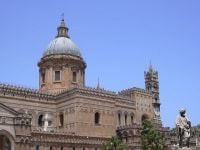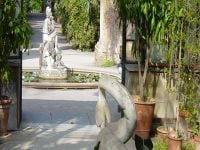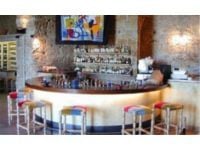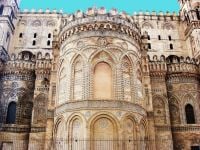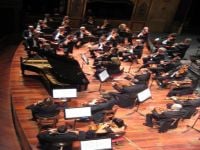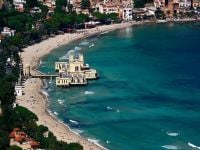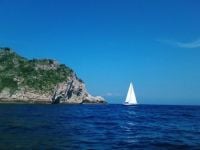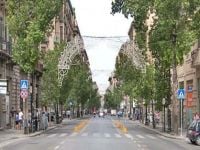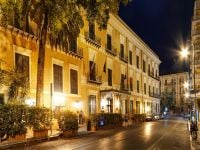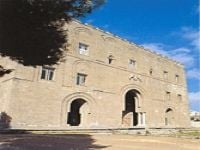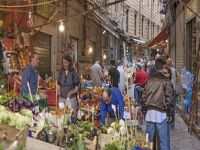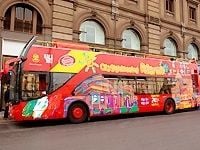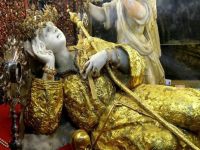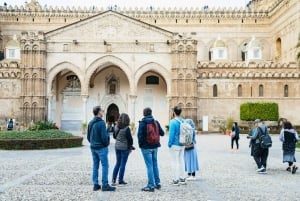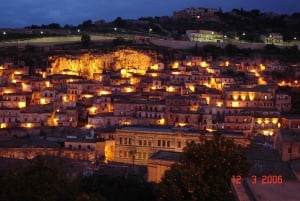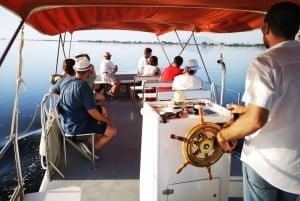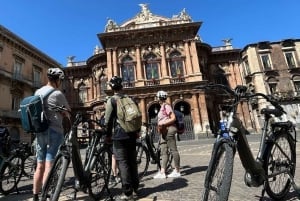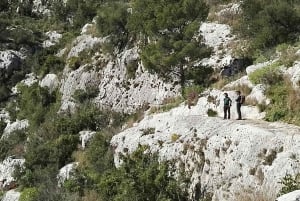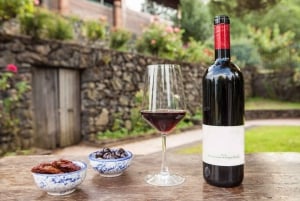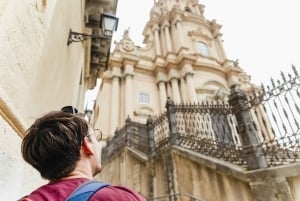Palermo
Palermo is......Palermo!
Bustling, fascinating, noisy, colourful, smelly, lively, multi-cultural capital of Sicily, situated at the foot of Monte Pellegrino on a gorgeous bay with a golden beach, thus the name Golden Shell – the only melting pot that has attracted almost every culture of the ancient Mediterranean world.
Phoenicians, Carthaginians, Greeks, Romans, Saracens, Normans, Swabians, French, English and the Spanish Bourbons – they invaded, stayed, ruled and left. Palermo has absorbed all these very different cultures and created a personality of its own. It is Arab and Christian, Roman and Byzantine, Norman and a little bit Italian, the latter only because people speak Italian – more or less.
(Video by courtesy of Todaro Net)
Walking around you will see everywhere traces of the city’s patchwork-history, not only in the stunning range of architectural styles, but also in the names which are definitely not of Italian origin. And when you have lunch or dinner at one of the numerous restaurants or bars you will discover a cuisine that is unique: you will rarely find your familiar Spaghetti Bolognese or Pasta al Pesto Genovese, but you will be offered tasty dishes which are influenced by the old Romans and Arabs, may it be fine dining or street food – always and in particular the Arab ancestors are greeting.
Churches, art galleries and museums boast magnificent art works, the town parks feature Mediterranean and subtropical plants. Travellers to Palermo should be somewhat adventurous, because they may have trouble to find a restaurant with a menu that is translated into six different languages, and they also may have difficulties communicating in English. But: who cares! Just dig in the (very often) faded grandeur of Palermo, dig in a way of life that doesn’t really belong to our time. Pay a visit to the lively street bazaars and outdoor markets, where the Arabic origins of the city are still evident today – narrow winding alleys and labyrinthine streets, the smells, colours, noise and array of foods will make you feel like being in an Arab souk. Above all there is the daily symphony of pedestrians and motorcyclists, honking cars and the foghorns of ships and cruise liners leaving the port.
Things to do and see in Palermo
Artistic delights abound everywhere: at squares, arcs and facades, in churches, town mansions, parks and patios. The most strikingly are the gold ground mosaics in the Cappella Palatina (Palatine Chapel).
The Cathedral’s exterior is a must-see, the interior is rather plain. The Norman King of Sicily and Emperor of the Holy Roman Empire, Frederick II of Hohenstaufen, is buried here.
Behind the City Hall at Piazza Bellini, you can see two of Palermo’s most interesting churches: Santa Maria dell'Ammiraglio, known as La Martorana, and San Cataldo with its red domes and which has retained its original ascetic atmosphere.
The church Chiesa del Gesù is a Baroque masterpiece built by the Jesuits. Much of the artwork inside was carried out by the Jesuit priests themselves and its florid decorations are still amongst the most splendid in Palermo.
The Catacombe dei Cappuccini is the spookiest sight of all in the whole of Sicily! This 16th-century catacomb houses nearly 9,000 corpses of men, women and young children, some in tombs, but many mummified and preserved, hanging in rows on the walls, divided by social caste, age, or gender. This is really not a spot for the faint of heart. Children might be disturbed or frightened.
The Palazzo Reale, also called Palazzo dei Normanni (Norman Palace), was the seat of Sicily's rulers for centuries. Upstairs are the royal apartments, including King Roger's Hall, decorated with Medieval murals of hunting scenes.
Quattro Canti is the centre point of the four areas of the old town centre. Four Baroque palaces meet at concave corners, each with its own fountain and representations of a Spanish ruler, patron saint, and one of the four seasons.
Directly opposite Teatro Massimo is Via Bara dell’Olivella, a narrow street famous for its craft shops and its puppet theatre, worth a visit on a Sunday afternoon for both adults and children. At the end is Piazza Olivella, one of Palermo’s nightlife centres and home to the imposing Baroque Church of Sant’Ignazio and the Regional Archaeological Museum. The museum houses, amongst other things, two large statues of Zeus dating back to the 2nd century BC and, in the lovely cloisters, several Greek and Roman statues taken from Solunto and Tindari.
Piazza Pretoria is home not only to a splendid fountain but several other impressive buildings including the City Hall.
Palermo is dotted with art galleries and museums, some of them are really particular and worth a visit are all of them. It is impossible to list them all here, so we ask you to have a look at our page Museums & Galleries
Spend a glamorous evening in the Teatro Massimo, Europe’s third largest opera house after L’Opéra de Paris and the Wiener Staatsoper, which opened its doors to the public in 1897 with a performance of Verdi’s Falstaff. The young Caruso sang here, same as the opera world’s famous stars Di Stefano, Maria Callas and Pavarotti. The opera season runs from mid November to the end of June. Another major theatre is the Teatro Politeama, built a few years earlier than the Teatro Massimo, which is a spectacular circular building structure with bronze sculptures.
Orto Botanico – Botanical Garden
Palermo’s Orto Botanico or Botanical Garden is more than 200 years old. It opened in 1789 and contains a huge range of species including exotic and oriental plants. Various plants were brought from South America in the 19th century. The Orto Botanico is a good place to relax, to recover from extended sightseeing and to get some shade in hot Sicilian summers.
Palermo with children
For children there are water amusement parks in Palermo and Monreale. At the Bioparco di Sicilia your kids can get nose to nose with nature, discover the land of dinosaurs, the terrarium, the acquarium and the mini zoo. What about enjoying the festive season and having a magical day at the Christmas Village? Or you show your children the Toy and Wax Museum. At the Bird Parl kids can feed exotic and Mediterranean birds, and we are sure that your offspring will love the parks' rule: entrance permitted only for adults accompanied by children. Another great thing to do is going to the puppet theatre Teatro di Mimmo Cuticchio.
More tips of how to keep your kids entertained in Sicily you will find here
Local Markets
There are several markets where you really can buy everything from fruit, veggies, meat, fish and spices to flowers, shoes, clothing, underwear and cosmetics to home ware. Don’t mind if you do not understand a word, even Italians don’t! And, like everywhere in the world where many people come together – beware of pickpockets. Palermo's markets are La Vucciria (the touristy), Il Capo (the busiest), Ballarò (the oldest) and Le Bancherelle. La Vucciria is really worth a visit, but we prefer Il Capo and Ballarò. Local tip: try the Palermitan street food “pane e panelle”
Sightseeing in Palermo
Organized sightseeing is boring? Not in Palermo. You got the choice between tours organized by a local acency, with a private guide and a hop on - hop off bus tour – your ticket is valid 24 hours and you can start and end your tour at each of the 15 bus stops, all named of the nearest attraction. A possibility to explore Palermo in a slightly different way is by bicycle. See more at Services
Four tips for your Palermo sightseeing:
Inform yourself: bring along a travel guide or, better, hire a local guide – the most interesting stories about the attractions are not written on their walls.
In winter: in summer Palermo is very often during the day like an oven. Plus the inevitable traffic and the many other visitors. So try to come between October and May and you will have Palermo, like the rest of Sicily, nearly for your own. And a mild climate.
By-streets: no, Palermo’s by-streets are not dangerous – on the contrary, Palermo is one of the safest cities in Italy. But many alleys are dark and narrow and you can get lost easily. We recommend staying on the main streets.
Food: like everywhere in the world you will find next to the attractions the usual tourist menus for a fixed price. We won’t say that they are bad, but if you stay away from the main tourist streams, you will savour the unexpected.
Just follow our tips and you will experience a city of contrasts – completely stress-free.
More interesting places to see
The area around Piazza Marina - Palazzo Belmonte Riso - Palazzo Steri - Palazzo Abatellis (Regional Art Gallery) - Piazza Maggione and the Basicilia della Maggione - Basilica San Francesco d'Assisi and the Giardino Inglese (English Garden)
Shopping in Palermo
If shopping is your thing: you name it, Palermo has got it!
Palermo's main shopping streets are between Teatro Massino and Piazza Politeama and along Via delle Libertá, the latter being home to more upmarket shops. From outside Teatro Massimo, go west along Via Ruggero Settimo where you will find some of the most exclusive shops in Palermo. Halfway down this road is a pedestrian street called Via Principe Belmonte with some nice bars and cafés where you can sit outside and watch the world go by. Antique shops you will find in Corso Alberto Amedeo, designer boutiques, local produce or pottery shops in Via Nicolo Gallo and Via Daita. Via Roma is Palermo’s best known shopping street, with all luxury and not so luxury brands of the world. It is a pleasure to shop here, because the Via Roma is a wide avenue with a little green, presenting all shops in a Mediterranean flair.
Need a refreshment? Then stop by at Enoteca Picone, which has a fantastic selection of Sicilian and national wines. Next to the Vucciria market is the department store La Rinascente, an absolute modern contrast to the historical market. Its roof terrace bar is a wonderful place to relax with a wide view over the roofs of Palermo. By the way – they speak English in Obikà Bar.
See more at Shopping
Restaurants in Palermo
There are restaurants, pizzerias, osterias, bars and trattorias in every street, alleyway, square and at every corner. Many of them serve local specialties and all of them serve very good quality and freshly cooked food. Don’t be surprised when you are offered, once you have eaten and are ready to pay, a Limoncello or Amaro for free by the owner himself. This is part of the Sicilian hospitality.
Eateries are here
Nightlife in Palermo
Palermo is at its most charming in the evening light, and as evening turns to night, Palermo can be wild as well as romantic with a busy nightlife. The squares come alive after dark with live music and entertainment, and all cafés and bars are full of people having a beer or eating an ice cream. Palermo's nightlife is best in the quarters Kalsa and Libertà, around Piazza Olivella, where you will find clubs, wine and cocktail bars, live music, pubs, restaurants and pizzerias.
A representative of the modern Palermo is Kursaal Kalhesa at Porta Felice near the port. It is one of Palermo’s most fascinating places to socialize. Kursaal Kalhesa has spectacular high ceilings and an idyllic courtyard, where you can enjoy your cocktail by live jazz music. Hungry? Their restaurant serves Sicilian food with an Arab touch, but it is a bit on the pricey side. Or do you prefer a cold beer? Then you should pay a visit to "Mikalsa", a very hip nightspot with Sicily’s best selection of Belgian beers. And why not start an evening at Teatro Massimo or Teatro Politeama, enjoying a theatre, opera or ballet performance or a classical concert.
Find more places to go at our Nightlife page
Mondello & Monte Pellegrino - for hikers & beach fans
Monte Pellegrino is Palermo’s pilgrims rock. You can hike up to the grotto of Santa Rosalia, Palermo’s adored patron saint, and enjoy stunning views of the sea. The best spot for swimming and water sports is right next to Palermo at the towns mundane bathtub Mondello, a charming seaside resort in Art Nouveau style, originally a fishing village with a golden sandy beach, beautiful villas, restaurants, cafés and watersport schools. Mondello is one of the most popular tourist destinations by both Sicilian and international level. The beach might be a bit crowded on weekends and in high season!
Accommodation in Palermo
Historical palazzos, mansions and townhouses house B&Bs, hostels, holiday apartments and hotels of all categories up to luxurious five star hotels - Palermo serves every budget and taste. You could even overnight in a convent. One of the most impressive hotels is the Excelsior Palace Hilton, which is located in a restored 19th century palazzo with art nouveau details. Guestrooms feature traditional decor and antique wooden furnishings. The Liberty Hall Restaurant serves Mediterranean cuisine in 19th century decor. See more at Accommodation
Events in Palermo
Every year around 15th of July the Palermitans celebrate the biggest event of the year – the Festa di Santa Rosalia, in honour of the city’s patron saint, who liberated Palermo in the year 1624 of the plague.
Find more festivals in Sicily here
Sailing the Med
Recommended come the modern yacht harbour "Acquasanta", just north of the two commercial harbour entrances, and "Cala" in the southern corner of the commercial harbour. Both harbours offer all services you may need. Touristic ports in Sicily you'll find here
How to get to Palermo
By airplane
Palermo International Airport “Borsellino e Falcone” is served by domestic and international flights. Taxis (20 min ride) and buses connect it to the centre and the port. You can also jump on a train which departs every half an hour from the airport station located in the underground and within 30 min you get to the main train station Palermo Centrale in Piazza Giulio Cesare.
By car
If you are not used to Sicilian city traffic: do not go to Palermo by car! It is not as bad as always said, but for Palermo-newcomers extremely stressing. In case you want to give it a try: there are some parking lots in the centre where you will always find a space. Parking fees are low.
By train
The most stress-free and comfortable way to reach Palermo is by train. Trenitalia connects Palermo to all mayor cities of Sicily.
By bus
The central station is also the bus terminal of Palermo. There are several private bus lines connecting Palermo with the rest of Sicily, so you will not find only one time table. There are also buses running to the airports of Palermo, Catania and Trapani. The most interesting connections for travellers are:
- from the central station in Messina (Piazza della Repubblica) with SAIS Autolinee
- from the central station in Catania (Via D’Amico) with SAIS Autolinee
- from Enna (Viale Armando Diaz) with SAIS Autolinee
- from Agrigento (Piazzale Rosselli) with Cuffaro
- from the train station in Marsala (Viale Amerigo Fazio) with Salemi
- from the train station in Trapani (Piazza Umberto) with Interbus/Segesta
By ferry boat
Car ferry connections to Genoa, Civitavecchia (Rome), Naples, Salerno (all Italian mainland), Cagliari (Sardinia) and Tunis in North Africa. This is definitely the most beautiful and impressing way to approach Palermo – standing on deck in the morning and seeing the Golden Shell appear out of the haze.
By cruise
Cruise liners dock in the port of Palermo. It is easy for cruise customers to do their Palermo sightseeing on foot. Visitors who want to explore the city by sightseeing bus just walk some 100 metres to the main port entrance to the bus stop "B7 Porto". Of course you can book excursions to the most instersting sites in Sicily on board, but if you prefer a private tour have a look at Services, where you'll find private guides and taxi and transfer companies.


